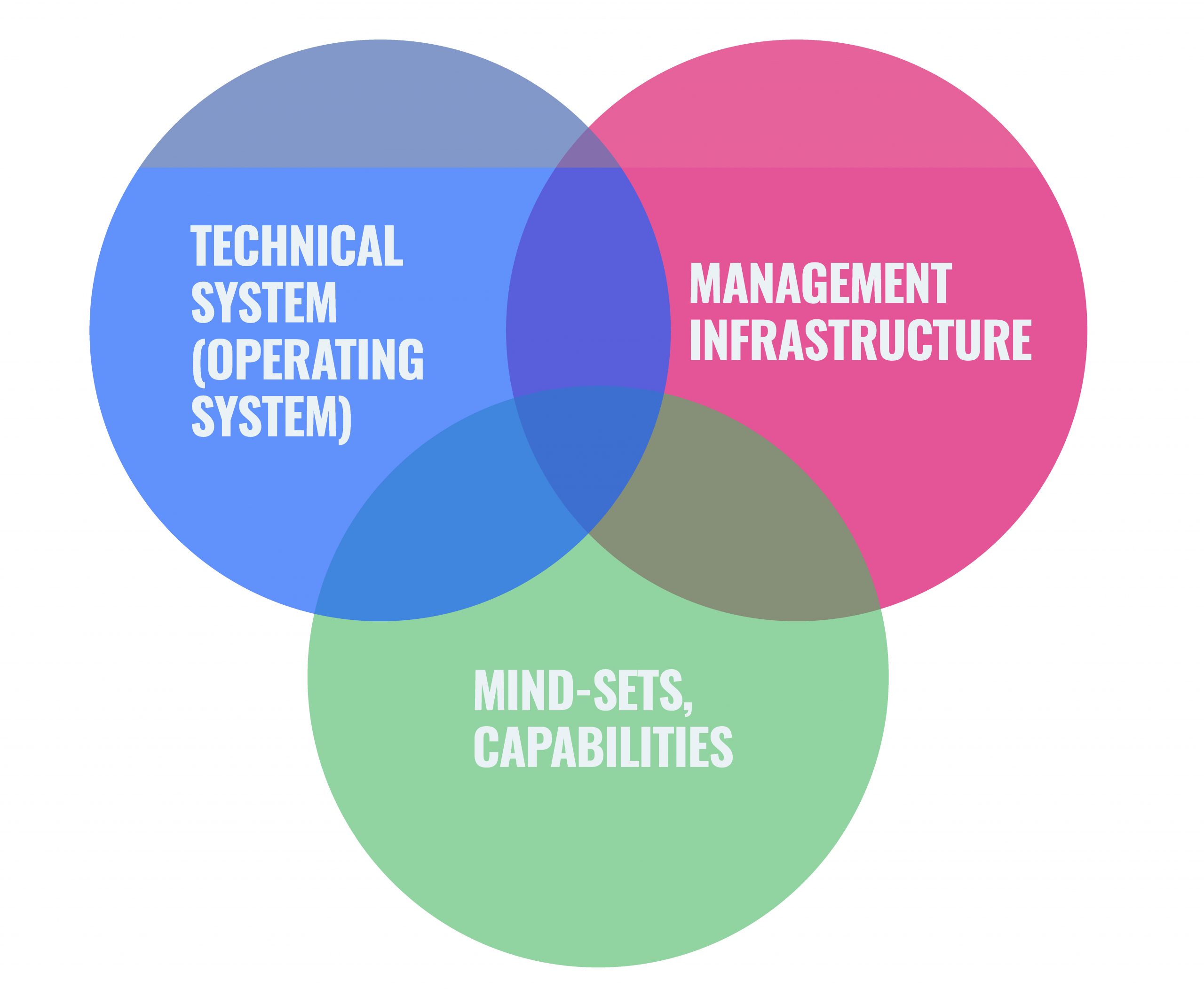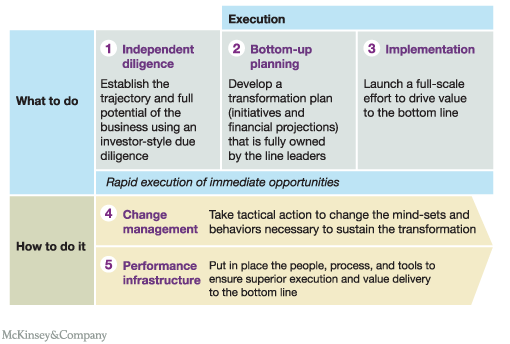Introduction
The term “operational improvement” is popular in the business lexicon, but its exact definition often varies greatly from one context to another. A common definition references ‘the improvement of business outcomes resulting from a combination of the implementation/presence of a solid technology infrastructure, that provides the foundation for efficient business processes embraced by an engaged user base. Led by a management team with sound strategic vision, with the ability to align the technology, business processes, and team members in order to drive value creation’.
McKinsey & Company provide an excellent visualization of this notion of operational improvement, that includes the overlapping technology, management and human elements of operational improvement initiatives.

Technical System (Operating System)
The way corporate resources are deployed to meet customer needs at lowest cost
- Production planning, logistics systems
- Quality systems, processes
- Labor allocation
- Maintenance systems, processes
Management Infrastructure
The way formal structures and processes are used to manage technical systems and achieve business objectives
- Performance management
- Talent Management (eg, recruiting, career paths, compensation)
- Organizational design, roles, responsibilities.
Mind-set Capabilities
The way people think and feel about their work and conduct themselves in their workplace
- Leadership alignment, role modeling
- Clear direction, compelling purpose
- Discipline, collaboration, accountability, trust
- Focus on coninuous improvement
- Effective individual skills
In the authors’ words:
“To get the most from large operational improvement programs, top companies look beyond the technical aspects of lean and six sigma and embrace the softer side. Complementing the development of technical skills with a focus on the organizational capabilities that make efficiency benefits real can help companies achieve more substantial, sustainable, and scalable results.”[1]
~ David Fine, Maia Hansen, Stefan Roggenhofer, McKinsey & Company
Trajectory’s experience supports this definition. ERP implementation ALONE does not equate to operational improvement. It requires far more nuance and effective balancing of technology, management and human capital elements. Achieving true operational improvement requires a robust ERP ecosystem that serves as the technology backbone supporting optimized business processes, and an effective change management strategy. Also needed is an accountable management team and capable, well-trained users. Read on to learn how Trajectory customer, Insurance Supermarket Inc., successfully leveraged our formula to achieve true operational improvement.
Topics you will learn about in this Insight include:
- The “what” and “how” of business and technology transformations
- 10 Keys to Operational Improvement success
- 8 Key reasons for ERP and Operational Improvement failure
- A case study of a Trajectory customer, Insurance Supermarket Inc
- How they effectively achieved operational improvement success
The “What” and “How” of Business and Technology Transformations
Through our experience and research in the operational improvement/tech transformation field, there are interesting connections between the conditions that drive both tech and business transformation. McKinsey & Company’s article entitled, “The “how” of transformation” outlines their approach to general business transformation, which in their words, covers both the “what” and the “how”.[2]

“To achieve extraordinary results, we believe a comprehensive, highly disciplined methodology—encompassing both the “what” and the “how”—is needed (exhibit). The “what” entails the smooth movement of the many specific transformation ideas and initiatives through three phases: from independent diligence to planning to implementation.”
~ Michael Bucy, Adrian Finlayson, Chris Moye, Greg Kell, McKinsey & Company
Similarly, Trajectory’s refined methodology leads to successful implementations:
Insurance Supermarket Inc. Case Study – Successful Operational Improvement Strategies in Action
Time to explore how best practices were implemented to deliver operational improvement for Trajectory customer, Insurance Supermarket Inc. (ISI), a Canadian based Insurtech company that offers a complete digital life insurance ecosystem experience for customers across Canada and the United States.
Global trends are reshaping consumer demands and impacting the insurance industry digital operating environment. Consumers are seeking more flexible, easy-to-access insurance products that are challenging the traditional norms of the insurance industry value creation and delivery model. There has been a recent shift away from a more traditional business model based on broker-driven interactions with customers to a more technology-driven, online shopping style sales process. In order to respond to these demands, innovative insurance provider, Insurance Supermarket Inc., engaged Trajectory to help them scale operations, increase platform fault tolerance and provide internal controls for this new insurance industry era via technology transformation.
ISI provides a full spectrum of personal protection and investment products that are tailored to suit clients’ budgets, lifestyles and needs at every life stage. This means a client can start with one set of contracts/policies based on their needs at the time they sign-up, but those policies can be changed and adapted during the course of the client’s life.
As stated by ISI CEO Alex Dudarev,
“ISI continues to lead the industry in innovative technology and processes that work effectively with partners to serve consumers in the next generation of insurance distribution. We know our process works because it more effectively reflects and serves the needs of consumers when they research, select and purchase life insurance today.”[3]

Our “What” includes working with key stakeholders to understand your business and help refine your business processes. Our “How” includes blueprint workshops, during which detailed business requirements are collected and amalgamated into a clear roadmap for configuring a full solution and ecosystem that achieve the associated business goals.
Any technology infrastructure needs a solid management team, engaged users and robust business processes to achieve true operational improvement. The key question we answer for our clients “How does one ensure operational improvement following implementation?”
8 Key Reasons for Failure: Understanding What Not to Do
A good place to start is to identify potential failure points. Interestingly, the top reasons for ERP implementation failure hold true for operational improvement failure. According to the Withum.com blog “ERP Implementation Failure: 8 Mistakes to Avoid”:
- Failure to Define and Plan Goals > Defining clear goals and outcomes of a desired operational improvement or ERP initiative are critical to ensure you have benchmarks that define success or failure. Doing this also keeps your “eye on the prize” when scope decisions come up throughout the implementation or operational improvement processes. Having a clear blueprint of what needs to be done and a detailed project plan including specific timelines ensures activities remain on track for achieving the desired outcomes.
- Insufficient Commitment > Underestimating the effort to achieve ERP or operational improvement initiatives is common. For a full ERP implementation, you can assume that thorough blueprinting and implementation processes can take 12-18 months to complete and core subject matter experts will need to devote up to half their time to support project activities at various stages during the implementation process. Then typically it can take up to another 6 months to work through post-implementation items and post Go-Live enhancements. For operational improvement initiatives, the timelines will depend on the nature of the initiative but the commitment of the team (including their buy-in) to complete the required work is a consistent and critical requirement.
- Lack of Expertise / Not Finding the Right Leader > Both ERP and operational improvement initiatives require the “right” team composition. What does “right” mean? It means a team including a strategic project/initiative champion who understands day-to-day operations but who also has a clear vision of the end state and has the authority to make decisions accordingly, key subject matter experts from each area of the business that the system will touch, and a detail-oriented PM who has the ability to work with the various stakeholders to get the job done, on time and on budget.
- Not Setting Milestones > The need for clear milestones is critical for both ERP and operational improvement initiatives. For ERP implementation, typically a waterfall approach by module/workstream works best so that one is always tracking against realistic dates to complete specific activities. In our experience, using an agile approach leads to over-extended timelines and shifting goal posts, with outcomes never being completely ready on appropriate timelines.
- Not Taking Data Migration Seriously Enough > Data migration needs to be a top priority from Day 1 of an ERP implementation project. Building a specific data migration plan that tracks all data elements being migrated, source systems, quantities, and data migration templates and ensuring all required data is accessible and cleansed are critical success factors for any ERP project.
- Addressing Fear of Change > This is a truism for any form of technology system or business process change. End users/change targets wonder what the impact of the change will be on them: will they be replaced, will the change make their lives easier or harder? Creating a clear communication strategy around the change that addresses the concerns/fears of all stakeholders is critical to project/initiative success. Business leadership must explain the change, “what’s in it” for the end users, and earn buy-in for the change. Without this aspect addressed, the project is more prone to failure.
- Failure to Train > The importance of training is key to system or new process adoption. Ensuring the teams being impacted by the changes are comfortable with the new systems or processes before they are asked to use them will go a long way to facilitating a smooth transition. For ERP projects, key subject matter experts are engaged in the unit and user acceptance testing processes and that is followed up with holistic system training just before Go-Live, supported with training videos and cheat sheets to ensure the end users have the tools they need to be successful.
- Not Planning for Post-Launch Maintenance > Focus is often centered around the planning and execution of the implementation or process change. But what happens after the change is implemented? For both ERP implementation and operational improvement initiatives, setting up an ongoing support infrastructure is critical.
10 Keys to Operational Improvement Success
Now that we know what not to do, let’s dive into what defines success:
- Realistic Expectations – Before an implementation begins the entire project team must have realistic expectations in terms of appropriate duration, cost, resources required, and timing (i.e. don’t plan main activities in parallel with the business’ busy season, etc.). This is often easier said than done and gaining insights into these elements from an experienced implementation partner will set these parameters early in the project lifecycle.
- Effective Change Management -Some would argue this is the most important factor in digital and/or operational transformation success. A solid strategy involves research to understand organizational readiness, change impacts, and defining a clear communication plan that articulates reasons, benefits, and support of the change to the entire business. The following elements should be present:[5]
- Executive Alignment – Executive sponsors must build the vision for the project and then be able to guide business process definition, connecting vision with tactical reality.
- Expose and Address Hidden Resistance to Change – An organization readiness assessment of your ability to prepare for, assist with and embrace change, is critical to help expose hidden resistance to change. It can then be addressed head-on by change management messaging.
- Thorough Understanding of Change Impacts – Alongside the organization readiness assessment, a change impact assessment, calling out impacts to front-line team members will help shape adoption and engagement of the project.
- Organizational Change – Most changes of this nature will involve some form of organizational change, in terms of company structure, tasks to be performed, role changes. Work to introduce the realities of the change early and inform affected team members of the scope, impact benefit and support of the change is critical to change success.
- Ensure Software Fits Majority of Users Needs – In ERP implementations, ensuring the software addresses users’ main pain points (and when it doesn’t explain why), is an important step towards facilitating system adoption.
- Training – Any smooth user adoption process should include support via recorded demonstrations that can be revisited as needed, live test cases, cheat sheets and Subject Matter Experts on call.
- Process Design – The design of new processes should involve representation from senior management and frontline team members. Having buy-in from both parties that the new processes will work for the business and align with the executive vision will assist all groups in being satisfied with the outcome of the initiative. In the case of ERP implementation, it’s advisable to keep as close to native system functionality as possible to avoid customizations that will need to be maintained on an on-going basis.
- Sound Implementation Partner & Methodology – Unless you have an experienced in-house ERP team, it’s critical to select a tried-and-true implementation partner who can guide your team through the requirements gathering, solution design and implementation processes. Ask candidates for references for similar projects (industry, complexity and scope), and for methodology overviews. Ensure they are business-focused rather than technology focused, i.e. ensure they want to learn your business first and figure out how to make the technology work to enhance your business processes. Having said that, the technology may not always do what you want out of the box, which is when a partner with in-house development capabilities is a real bonus.
- Solid Governance Team & Methodology – Create your project team: Project Sponsor, Project Lead, Subject Matter Experts (representing all areas of the business that will be impacted), and a Project Manager who will keep the project on track. Stakeholders will be engaged, informed, and able to make decisions aligned with project goals. Scheduling regular status calls with day-to-day primes and monthly Steering Committee meetings will provide forums to actively identify and manage risks.
- Thorough Blueprinting Involving All Stakeholders – When kicking off a large operational improvement or ERP initiative, the tendency is to jump right into solutioning. However, best practice dictates that conducting thorough business process analysis exercises to understand what is required, accompanied by a detailed solution document or “implementation roadmap” are critical success factors. Based on this document, an estimated budget and timeline (including a detailed project plan) can be determined for the implementation. Key points to remember during the blueprint process:
- Determine the most streamlined technology ecosystem to achieve desired business outcomes. Implement a base ERP solution with basic automation and then settle into that solution before embarking on more complex optimizations.
- Conduct the blueprint sessions from a business-first vs. system-first perspective.
- Identify the complexities early, so that they can be actively addressed or tabled for later consideration.
- Taking Data Migration Seriously – Building on the points made above about the importance of data migration, a system is only as good as the data it contains. It is important to consider not only static or master data requirements (vendors, customers, employees) but also dynamic or transactional data (in progress transactions, in-progress projects) and related revenue impacts. Having quality data to use for unit and User Acceptance Testing minimizes risk upon Go-Live.
- Thorough Testing Plan/QA Framework – The importance of allowing appropriate time for thorough solution testing cannot be emphasized enough. At minimum, test cases should cover all common business scenarios (including click-level instructions), but it’s a good idea to compile a list of corner cases. A precursor for optimal testing is having clean test data, so the testing team gets a sense of how the system will work upon Go-Live. The more accurate the scenarios and data, the more likely it is that issues will be identified during the testing phases vs. after Go-Live. Best practice dictates testing is ideally conducted by system end users rather than a separate testing team. Gathering team members in a room and having them test in sequence to mimic the business processes also helps ensure there are no process gaps or desired results. Although more time-consuming for end users, the testing cycles will serve as an early training opportunity to get them used to working in the new system.
- Detailed Training Plan – Engaging key stakeholders early in the testing process, during the system build, and during final user acceptance testing is a good way to get them acclimatized to the solution. Following up just prior to Go-Live, with business process training (recorded for future reference) and assigning subject matter experts in each department to field on-going questions and provide system support will help smooth the transition. Creating an internal learning management system or repository of training materials is also recommended.
- Thorough Cutover Planning – Often with the elevated tempo of final system and process testing, the plan for cutover can easily be overlooked. It’s important to meet with all stakeholders about 6 weeks to a month before Go-Live to articulate the actions required with getting a new system or process up and running. Document steps, timing and who’s responsible for each, so the Go-Live game plan is clear to everyone. After all the work it takes to get to cutover, thorough Go-Live planning and coordination are worth the investment, especially given that the broader business’ perception of the change will be impacted by the smoothness of cutover.
- Maintenance and Support – Ensuring that end users have a feedback process and on-going support for questions and concerns is optimal to facilitate the success of system adoption, optimization and improvement efforts. Setting up a help desk and/or contact to field on-going system questions and collect feedback in a timely manner can go a long way to supporting positive system adoption for the long-term
Case Study: Successful Operational Improvement Strategies in Action – Insurance Supermarket Inc.
Time to explore how best practices were leveraged to deliver operational improvement for Trajectory customer Insurance Supermarket Inc. (ISI), a Canadian-based Insurtech company offering a complete digital life insurance experience for customers across Canada and the United States.
Global trends are reshaping consumer demands and impacting the insurance industry digital operating environment. Consumers are seeking more flexible, easy-to-access insurance products that are challenging the norms of the insurance industry value creation and delivery model. There has been a shift away from a more traditional business model based on broker-driven interactions to a technology-driven, online shopping-style sales process. To respond to these demands, innovative insurance provider Insurance Supermarket Inc., engaged Trajectory to help them scale operations, increase platform fault tolerance and provide internal controls for this new insurance industry era using technology transformation.
ISI provides a full spectrum of personal protection and investment products that are tailored to suit clients’ budgets, lifestyles and needs at every life stage. A client can start with one set of contracts/policies based on their needs at the time, and those policies can be changed and adapted during the course of the client’s life.
As stated by ISI CEO Alex Dudarev,
“ISI continues to lead the industry in innovative technology and processes that work effectively with partners to serve consumers in the next generation of insurance distribution. We know our process works because it more effectively reflects and serves the needs of consumers when they research, select and purchase life insurance today.”

Insurance Supermarket Inc.’s Operational Improvement Goals
For the engagement with Trajectory, ISI’s operational improvement goals were identified:
- Support ISI’s Business Proposition – The ability to tailor insurance offerings to suit clients’ needs at every life stage and to adapt to clients’ changing requirements.
- Scalable ERP & Payment Processing Infrastructure – Building a solid ERP and automated payment processing based on the Oracle-NetSuite platform that would automate the entire order-to-cash process, allow ISI to scale quickly in both the US and Canada, and easily add new products.
- Automate Policy Issuance and Record Associated Financial Impacts – Enabling ISI to automatically create and track policies through a custom process in Oracle-NetSuite, covering the creation of the policy through to customer payment, tracking, and updating changes to policy terms over time.
- Automated Payment Integrations – Creating automated payment connections between Oracle-NetSuite, ChargeOver (ACH payment processor), and Converge (cc payment processor) including receiving and storing response information related to successful, failed (i.e. NSF), and retry payment attempts.
Setting the Stage for Operational Improvement Success
The necessity for ERP migration and process automation was clear. In the words of Kameron Javaid, Vice President of Finance;:
“We knew that undertaking this technology transformation was strategically critical for allowing us to scale the business and support future growth, both in terms of geography and product lines. The automation of our policy payment processing was a significant part of the project, in order to optimize our operational efficiency. The integrated real-time reporting was going to be invaluable for managing the business. Trajectory was the implementation partner that had the right combination of business understanding and technical capability to deliver our desired solution on a reasonable timeline.”
Kameron Javaid, Vice President of Finance, Insurance Supermarket Inc.
The engagement with ISI began with realistic expectations. Their leadership team had established clear objectives for the implementation and had a clear vision of the desired end state. The thorough blueprint process helped establish a realistic budget and timeline. Trajectory allowed ISI to understand that the blueprinting and base ERP implementation process would take about a year and to plan for another 6-12 months of follow-up support for the solution to stabilize.
While the engagement was underway, the ISI Finance team were educated about reasons for the implementation and the important role it would play in the future growth of the business. Other key stakeholders were engaged in the blueprint and implementation processes and, working with an experienced implementation partner with a tested methodology ensured the project remained on track and on budget.
ERP Implementation Excellence: Avoiding the Common Pitfalls
Trajectory’s thorough blueprinting process uncovered key project requirements including integration needs between Platform ( policy management solution), Oracle-NetSuite, and the credit card / ACH payment processing solutions forming the overall technology ecosystem. The in-house consultant and development teams at Trajectory created a seamless blueprint plan. The development team chose Boomi to create a high-volume transaction processing infrastructure to track invoices, payments and declines seamlessly, as well as handle various associated transactions such as changes to policy dates, payment methods, and payment retries. Close collaboration between Trajectory’s development and consulting teams ensured that configuration and integration work streams were always aligned.
The data migration strategy was tackled from the very first week of project implementation. This was crucial to project success as it took the entire build and User Acceptance Testing cycle to get the data accurately cleansed and mapped for Go-Live. The timeline included test loads to verify the data flowed as expected. Special attention had to be paid to the large volume of transactional (policy) data to be migrated.
System testing took place in two stages during the implementation. Initially after the module level (Order Management, Accounting) and individual integration functionality were built, testing was completed by subject matter experts to validate whether business requirements had been met or exceeded. Once the entire solution was built, the second round of User Acceptance Testing (UAT) was completed to ensure correct functionality. Testing use cases consisted of a combination of base system functionality-specific business scenarios generated by subject matter experts.
Training consisted of system demonstrations prior to the unit and UAT testing cycles, supplemented with business process demonstrations just prior to Go-Live. A train-the-trainer approach worked well, whereby subject matter experts were prepared to deliver materials and sessions to their corresponding team members. All sessions were recorded to be referenced later as required.
Cutover planning began 6 weeks before Go-Live. Members of both Trajectory and ISI technical and business teams met and aligned on an action plan to be collectively followed during the Go-Live period.
Post Go Live support support was also pre-planned. An escalation process was established, empowering ISI to end users to identify escalation primes (Trajectory and ISI), provide usable feedback, and capture recommendations. This structure not only provided unified, timely support during solution adoption but provided extra support for the ISI Finance team during the first period close cycle. Supported closely by Trajectory through all steps, ISI gained successful system adoption.
The Proof is in the Outcomes
As a result of Trajectory’s ERP implementation methodology, Insurance Supermarket Inc. is now able to:
- Offer cutting-edge reflexive insurance. products in both the US and Canadian markets.
- Access a single source of management and operational data via real-time reporting with multiple currency capabilities.
- Leverage Oracle-NetSuite’s Commissions feature to automate the calculation of commissions and bonuses.
- Quickly scale up using Oracle-NetSuite’s streamlined, automated payment processing, bank reconciliation and financial consolidation.
To Wrap Up
‘With over 350 successful ERP implementations under our belts, we know that operational improvement is a combination of art and science – a blending of solid executional methodology, technology infrastructure knowledge, and experience-based business strategy.
We’re a partner that will expertly guide you through the entire process, led by our core values of professionalism, diligence and transparency. We are constantly ‘in pursuit of better’.
Citations
1. ‘From lean to lasting: Making operational improvements stick’. McKinsey.com https://www.mckinsey.com/business-functions/operations/our-insights/from-lean-to-lasting-making-operational-improvements-stick
2. ‘The ‘how’ of transformation’. McKinsey.com https://www.mckinsey.com/industries/retail/our-insights/the-how-of-transformation
3. ‘The ‘how’ of transformation’. McKinsey.com https://www.mckinsey.com/industries/retail/our-insights/the-how-of-transformation
4. ‘ERP Implementation Failure: 8 Mistakes to Avoid’. Withum.com https://www.withum.com/resources/erp-implementation-failure-8-mistakes-to-avoid/
5. ‘Organizational Change Management: The #1 Key to Digital Transformation Success’ Thirdstage Consulting. https://www.thirdstage-consulting.com/organizational-change-management-the-1-key-to-digital-transformation-success/

Alex Olano
CEO, Managing Partner
Throughout his 18-year career at Trajectory, Alex’s role has ranged from managing teams and projects to running the professional services organization, and mentoring Trajectory’s growing number of Consultants. Currently, he leads the Trajectory Team and invests his time ensuring Private Equity avoids key technology risks during their transactions. Alex understands technology is simply the means for achieving business goals. He has guided Trajectory’s organization to form its own version of Operational Improvement, which combines industry and business acumen with highly effective technology implementation capabilities. Prior to joining Trajectory Group, Alex spent 10 years in business consulting, systems advisory, and SAP implementations with IBM Global Services and Accenture.



